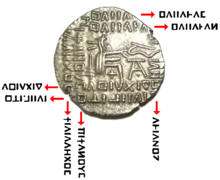Royal formula of Parthian coinage
Appearance


Greek inscriptions similar to "ΒΑΣΙΛΕΩΣ ΒΑΣΙΛΕΩΝ ΑΡΣΑΚΟΥ ΕΥΕΡΓΕΤΟΥ ΔΙΚΑΙΟΥ ΕΠΙΦΑΝΟΥΣ ΦΙΛΕΛΛΗΝΟΣ", meaning "[coin] of king of kings Arsaces, the benefactor (Euergetes), the just (Dikaios), the illustrious (Epiphanes), friend of the Greeks (Philhellen)", are found on coins of the Parthian Empire, starting from the reign of Artabanus I.[1] Some variations of this inscription exist.
The name Arsaces indicates the Arsacid dynasty and appears until the period of Phraates IV.[2]
Transliteration
[edit]BASILEOS BASILEON ARSAKOU EUERGETOU DIKAIOU EPIPHANOUS PHILHELLENOS.[3][4][5]
Literal translation
[edit]Some of the more frequent epithets appearing in the royal formula:
- ΒΑΣΙΛΕΩΣ ΒΑΣΙΛΕΩΝ = Of the King of kings
- ΜΕΓΑΛΟΥ = the Great (genitive form)
- ΑΡΣΑΚΟΥ = Arsaces (genitive form)
- ΕΥΕΡΓΕΤΟΥ = Euergetes, the Benefactor (genitive form)
- ΑΥΤΟΚΡΑΤΟΡΟΣ = Autokratōr, absolute ruler (genitive form)
- ΔΙΚΑΙΟΥ = Dikaios, the Just (genitive form)
- ΕΠΙΦΑΝΟΥΣ = Epiphanes, the Illustrious (genitive form)
- ΦΙΛΟΠΑΤΟΡΟΣ = Philopator, father-loving (genitive form)
- ΦΙΛΕΛΛΗΝΟΣ = Philhellene, the Friend of the Greeks (genitive form)
References
[edit]- ^ a b A catalogue of the Greek coins in the British Museum - "Catalogue of coins of Parthia", by Warwick William Wroth, 1903, p. 201, Oclc-id 3187578
- ^ Warwick William Wroth, 'On the Rearrangement of Parthian Coinage', N. C., 1900, pp. 181-202
- ^ "Drachm - Vologases III, Sellwood Type 78 - Ecbatana, Persia (ancient)". En.numista.com. Retrieved 21 August 2017.
- ^ "Drachm - Phraates IV, Sellwood Type 54, Persia (ancient)". En.numista.com. Retrieved 21 August 2017.
- ^ "Coin". British Museum. Retrieved 21 August 2017.
